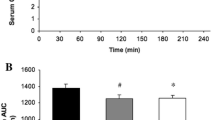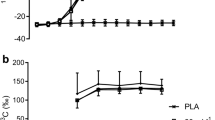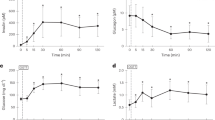Summary
Intestinal perfusion studies have shown that glucose absorption from maltose occurs faster than from isocaloric glucose. To determine whether ingested maltose might be a superior source of carbohydrate (CHO) for endurance athletes, we compared the rates of gastric emptying, absorption and oxidation of 15 g · 100 ml−1 solutions of maltose and glucose. Six endurance-trained cyclists drank 1200 ml of either U-14C maltose or U-14C glucose as a 400-ml loading bolus immediately before exercise, and as 8 × 100-ml drinks at 10-min intervals during a 90-min ride at 700% of maximal oxygen consumption. The rates of gastric emptying [maltose 690 (SD 119) ml · 90 min−1; glucose 655 (SD 93) ml · 90 min−1], the appearance of U-14C label in the plasma, and the peak rates of exogenous CHO oxidation [maltose 1.0 (SD 0.09) g · min−1; glucose 0.9 (SD 0.09) g · min−1] were not significantly different. Further, the 51 (SD 8) g of maltose and the 49 (SD 9) g of glucose oxidised during exercise were similar. Each accounted for approximately 2001o of the total CHO oxidised during the 90 min of exercise. Since only half of the CHO delivered to the intestine was oxidised in the 90-min ride (maltose 49%; glucose 50%), we conclude that neither the rate of gastric emptying, nor digestion limited the rate of ingested CHO utilisation during the early stages of exercise. Rather, we hypothesise that, initially, it could be the rate at which the CHO diffuses across the unstirred water layer of the brush-border of the intestinal villi that limits the utilisation of soluble CHO ingested during prolonged exercise.
Similar content being viewed by others
References
Barclay GR, Turnberg LA (1988) Effect of moderate exercise on salt and water transport in the human jejunum. Gut 29:816–820
Borg G (1975) Simple rating methods for estimation of perceived exertion. In: Borg G (ed) Physical work and effort. Pergamon, New York, pp 39–46
Consolazio GR, Johnson RE, Pecora LT (1963) Physiological measurements of metabolic functions in man. McGraw-Hill, New York, pp 72–87
Cook GC (1973) Comparison of absorption rates of glucose and maltose in man in vivo. Clin Sci 44:425–428
Crane RK (1975) 15 Years of struggle with the brush border. In: Csaky TZ (ed) Intestinal absorption and malabsorption. Raven Press, New York, pp 127–139
Fairclough PD, Silk DBA, Webb JPW, Clark ML, Dawson AM (1977) A reappraisal of ‘osmotic’ evidence for intact peptide absorption. Clin Sci Mol Med 53:241–248
Gray GM, Santiago NA (1966) Disaccharide absorption in normal and diseased human intestine. Gastroenterology 51:489–498
Hanke DW, Harden DA, Evans JO, Fannin FF, Diedrich DF (1980) The kinetic advantage for transport into hamster intestine of glucose generated from phlorizin by brush-border beta-glucosidases. Biochem Biophys Acta 599:652–663
Hawley JA, Noakes TD (1992a) Peak sustained power output predicts\(\dot VO_{2\max } \) and performance in trained cyclists. Eur J Appl Physiol (in press)
Hawley JA, Dennis SC, Laidler BJ, Bosch AN, Noakes TD, Brouns F (1991) High rates of exogenous carbohydrate oxidation from starch ingested during prolonged exercise. J Appl Physiol 75:1801–1806
Hawley JA, Dennis SC, Noakes TD (1992b) Oxidation of carbohydrate ingested during prolonged exercise. Sports Med (in press)
Jones BJM, Brown BE, Loran JS, Edgerton D, Kennedy JF, Stead JA, Silk DBA (1983) Glucose absorption from starch hydrolysates in the human jejunum. Gut 24:1152–1160
Jones BJM, Higgins BE, Silk DBA (1987) Glucose absorption from maltotriose and glucose oligomers in the human jejunum. Clin Sci 72:409–414
Kenny AJ, Maroux S (1982) Topology of microvillar membrane hydrolases of kidney and intestine. Physiol Rev 62:91–128
Massicotte D, Peronnet F, Allah C, Hillaire-Marcel C, Ledoux M, Brisson G (1986) Metabolic response to [13C] glucose and [13C] fructose ingestion during exercise. J Appl Physiol 61:1180–1184
Massicotte D, Peronnet F, Brisson G, Bakkouch K, Marcel CH (1989) Oxidation of glucose polymer during exercise: comparison with glucose or fructose. J Appl Physiol 66:179–183
Maughan RJ, Leiper JB, McGaw BA (1990) Effects of exercise intensity on absorption of ingested fluids in man Exp Physiol 75:419–421
Moodley DG, Noakes TD, Bosch AN, Hawley JA, Schall R, Dennis SC (1992) Oxidation of exogenous carbohydrate during prolonged exercise; the effects of the carbohydrate type and concentration. Eur J Appl Physiol 64:328–334
Noakes TD, Rehrer NJ, Maughan RJ (1991) The importance of volume in regulating gastric emptying. Med Sci Sports Exerc 23:307–313
Pallikarakis N, Jandrain B, Pirnay F, Morosa F, Lacroix M, Luyckx AS, Lefebvre PJ (1986) Remarkable metabolic availability of oral glucose during long-duration exercise in humans. J Appl Physiol 60:1035–1042
Rehrer NJ (1990) Limits to fluid availability during exercise. De Vrieseborch, Haarlem
Rowell LB, Blackmon JR, Bruce RA (1964) Indocyanine green clearance and estimated hepatic blood flow during mild exercise to maximal exercise in upright man. J Clin Invest 43:1667–1690
Sandle GI, Lobley RW, Holmes R (1982) Maltose hydrolysis and absorption in the human jejunum. Digestion 24:137–145
Williams JH, Mager M, Jacobsen ED (1964) Relationship of mesenteric blood flow to intestinal absorption of carbohydrates. J Lab Clin Med 63:853–863
Winne D (1984) Models of the relationship between drug absorption and intestinal blood flow. In: Shepherd AP, Granger DN (eds) 0Physiology of intestinal circulation. Raven Press, New York, pp 289
Author information
Authors and Affiliations
Rights and permissions
About this article
Cite this article
Hawley, J.A., Dennis, S.C., Nowitz, A. et al. Exogenous carbohydrate oxidation from maltose and glucose ingested during prolonged exercise. Europ. J. Appl. Physiol. 64, 523–527 (1992). https://doi.org/10.1007/BF00843762
Accepted:
Issue Date:
DOI: https://doi.org/10.1007/BF00843762




